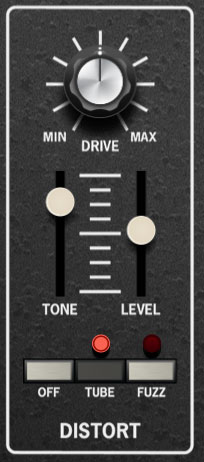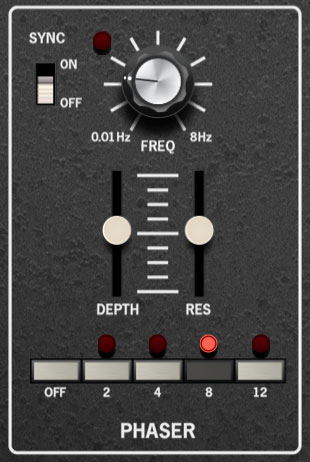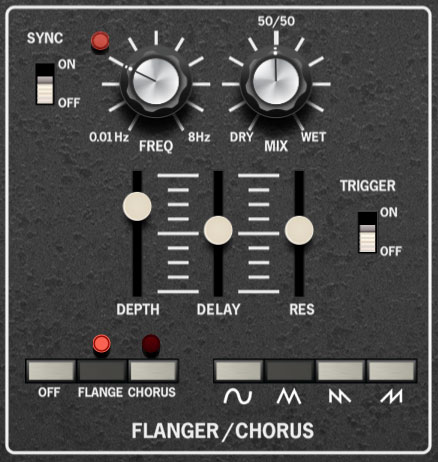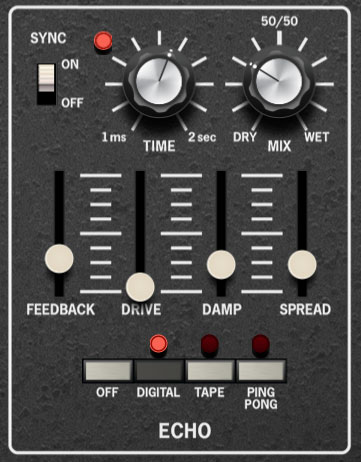
The Cat includes five simultaneous effects: Distortion, Phaser, Flanger/Chorus, Delay, and Reverb. These can be used in any combination.
Distort

Drive- Overall amount of distortion.
Tone- Sets the brightness of tone.
Level- Overall volume; this doesn't affect the amount of distortion. Increasing drive will cause an overall volume increase, Level can used to balance things out.
Mode buttons-
Off- Distort effect is disabled.
Tube- Relatively mellow distortion mode. Use it to add just little bit of vintage hair to sounds.
Fuzz- Aggressive and raunchy vintage fuzz tone.
Phaser

Sync- The Sync slide switch locks the rate of the Phaser's modulation LFO to the tempo in the top toolbar when using The Cat standalone version, or to the current project tempo when the plug-in version is used in a DAW. When engaged, the Freq knob snaps to note values ranging from 1/64th note triplet to 8 beats.
Freq- Sets the phaser's internal LFO speed from 0.01 to 8 Hz.
Depth- Sets the effect depth - essentially an amount control.
Res (Resonance)- Increasing the amount of Res intensifies the phasing effect. This is sometimes referred as "feedback" in other phaser units.
Mode buttons-
Off- Phaser effect is disabled.
2/4/8/12 Stage setting- The Cat's phaser includes up to 12 all-pass filter stages. As a general rule, more stages = lusher phase, but there are plenty of interesting tones to be had using the lower stage settings.
Flanger/Chorus

We've included a thick and warm flanger/chorus effect. Flanging and Chorus are closely related - the general difference being that flangers use a shorter time range and some amount of feedback (this intensifies the "jet-flyby" whoosh), whereas choruses utilize a slightly longer delay time, and no feedback.
Sync- The Sync slide switch locks the rate of the Flanger/Chorus's modulation LFO to the tempo in the top toolbar when using The Cat standalone version, or to the current project tempo when the plug-in version is used in a DAW. When engaged, the Freq knob snaps to note values ranging from 1/64th note triplet to 8 beats.
Freq- Sets the flanger/chorus internal LFO speed from 0.01 to 8 Hz.
Mix- Sets the ratio of clean to effected sound. Flanging and chorusing is usually optimal at a 50/50 setting, but we've added the Mix control by popular demand to allow more subtle (or warble-riffic) tones.
Depth- Sets effect depth, i.e. the amount of modulation.
Delay Time- Sets the amount of delay time when in Flanger mode, from 1-13ms.
Res- Sets the amount of internal feedback when in Flange mode.
Trigger- This is a fun and unique feature that forces the modulation wave to restart when a key is pressed. It's most noticeable and useful in Flange mode, with short Delay times and high Res settings.
Note that the mod wave restart is monophonic - that is, the wave only restarts if no other keys are currently being held.
Mode buttons-
Off- Flanger/Chorus effect is disabled.
Flange- Flange mode is enabled.
Chorus- Chorus mode is enabled. Note that the Delay and Res sliders are disabled when in Chorus mode.
Modulation Waves- Selects the shape of the modulation waveform. Options include sine, triangle, sawtooth, and ramp.
Echo

Sync- The Sync slide switch locks the delay time to master tempo. When engaged, the Time knob snaps to note values ranging from 1/64th note triplet to 8 beats. Sync mode locks to the tempo in the top toolbar when using The Cat standalone version or the current project tempo when the plug-in version is used in a DAW.
Time- Sets delay time, from 1 to 2000 ms. If the Sync button is enabled, time settings snap to synchronized note values.
Mix- Sets the ratio of clean to effected sound.
Feedback- Routes the output to the input for additional repeats. Be careful at high settings as this can result in runaway feedback madness.
Drive- Adds subtle-to-not-so-subtle breakup to echo repeats only.
Damp- Attenuates high-frequencies as the knob amount is increased. Not only does this create more natural sounding decays, it also reduces the "stacking" effect that occurs with high feedback levels.
Spread- Alters the left and right channel delay times creating a stereoizing effect. Greater amounts of spread increase the delay time differential and thus the stereo separation.
Mode buttons-
Off- Disables Echo effect.
Digital- A pristine sounding digital delay.
Tape- Reproduces the effect of a vintage "space echo" tape delay.
Ping Pong- Echoes alternate between audio channels.
Reverb

Decay- Sets the length of reverb release time/size of room.
Mix- Sets the ratio of clean to effected sound.
HP- A highpass filter affecting wet reverb signal only. Low frequencies are increasingly attenuated as the knob setting is increased.
LP- A lowpass filter affecting wet reverb signal only High frequencies are increasingly attenuated as the knob setting is decreased.
Mode buttons-
Off- Disables Reverb effect.
Spring- Recreates mechanical spring-reverb effect often seen (and kicked) in vintage guitar amps.
Room- Recreates a vintage algorithmic-style medium room verb.
Plate- A medium-to-large studio plate-style algorithm.
Hall- A large, hall-style reverb.
Galactic- Cherry Audio's exclusive, giant, spacey reverb.